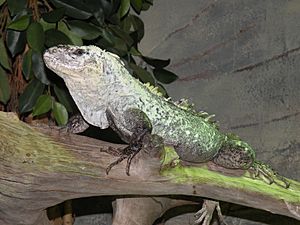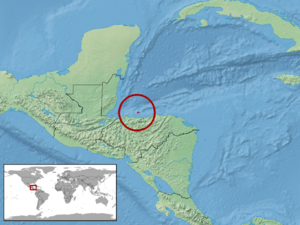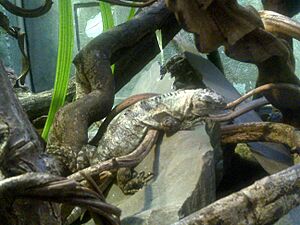Utila spiny-tailed iguana facts for kids
Quick facts for kids Ctenosaura bakeri |
|
|---|---|
 |
|
| Conservation status | |
| Scientific classification | |
| Genus: |
Ctenosaura
|
| Species: |
bakeri
|
 |
|
| Synonyms | |
|
|
The Utila spiny-tailed iguana, also called Ctenosaura bakeri, is a special kind of lizard. It's also known as Baker's spinytail iguana, swamper, or wishiwilly del suampo. This iguana is only found on Utila Island. Utila is one of the Islas de la Bahía (Bay Islands) near Honduras in the Caribbean Sea.
This iguana is very unique. It's one of only two lizard species that live only in mangrove swamps. These are forests that grow in salty water. The Utila iguana was likely forced to live there because bigger iguanas took over other areas. It's the smallest of the three iguana species on Utila.
Unlike other spiny-tailed iguanas, the Utila iguana is born dark. Other types are born bright green or yellow. These iguanas live in trees and mostly eat plants. But they will also eat small animals if they get the chance. Male iguanas can grow up to 76 centimeters (30 in) long. Females are smaller, reaching about 56 centimeters (22 in).
Female iguanas lay their eggs on sandy beaches. The eggs hatch after about 60 to 76 days. The baby iguanas then go back to live in the mangrove forests. By the 1990s, this iguana was almost gone due to hunting. A German scientist named Dr. Gunther Köhler helped bring attention to them.
Many zoos and wildlife groups have started programs to help these iguanas. But they are still in danger from hunting and losing their homes. People are working hard to save this amazing species from disappearing forever.
Contents
Meet the Utila Spiny-Tailed Iguana
Ctenosaura bakeri was first described in 1901. This was done by Leonhard Stejneger, an American zoologist from Norway. He worked for the Smithsonian Institution. The name Ctenosaura comes from two Greek words. Ctenos means "comb," which refers to the comb-like spines on the iguana's back and tail. Saura means "lizard."
The second part of its name, bakeri, honors Frank Baker. He was a friend of Stejneger and a past director of the National Zoo in Washington, D.C. Scientists believe this iguana came from ancestors on the mainland. It might be related to C. melanosterna and C. palearis.
Where Utila Iguanas Live

The Utila spiny-tailed iguana lives only on Utila Island. This island is off the northern coast of Honduras. These iguanas live in about 8 square kilometres (3.1 sq mi) of mangrove forests. It's very rare for a lizard to live only in mangrove forests.
Scientists think that bigger, more aggressive iguanas, like C. similis, pushed C. bakeri into the mangrove swamps. C. similis usually lives in drier areas on Utila. The Utila iguana has even bred with C. similis and had healthy babies. Living in salty mangrove forests means these iguanas have special ways of eating and behaving. They are one of only two lizard species known to live only in mangroves. The other is a type of anole lizard called Anolis utilensis.
Appearance of the Utila Iguana
Young Utila iguanas are grey-brown to black. This is special because other spiny-tailed iguanas are green or yellow when they are young. They turn darker as they get older. As the Utila iguana grows, its color can change. It might be blue or light gray. This depends on how warm it is or even how the iguana is feeling.
Male iguanas can grow up to 76 centimeters (30 in) long, including their tail. Females are usually about 30% smaller, reaching 56 centimeters (22 in). Males have a small flap of skin under their chin called a dewlap. They also have a crest on their back with 56 large spines. This crest has white and black spines in groups of two or three. These differences make it easy to tell males and females apart.
What Utila Iguanas Eat
Like most iguanas, Ctenosaura bakeri mainly eats plants. They munch on flowers, leaves, stems, and fruit. But they are also opportunistic eaters. This means they will eat smaller animals, eggs, and insects found in the mangroves if they get the chance. They have even been seen eating small green iguanas and geckos.
Life Cycle and Reproduction
Adult Utila iguanas live in holes in mangrove trees. They spend most of their time in the trees. But young iguanas live on the ground for their first year. Female iguanas cannot lay their eggs in the mangrove swamps. So, when they are ready to lay eggs, they travel to nearby sandy beaches. They dig nests and bury their eggs there. The eggs need the hot sun to hatch.
After laying their eggs, the mothers leave the nests and go back to the mangroves. About 60 to 74 days later, the baby iguanas hatch. They are about 15 centimeters (5.9 in) long. Their body is only 3 centimeters (1.2 in), and their tail is 12 centimeters (4.7 in). The dark skin of the hatchlings helps them hide on the dark floor of the mangrove forests. This keeps them safe from predators.
Saving the Utila Iguana
In 1994, Gunther Köhler found that the Utila iguana was almost gone in the wild. This was because of too much hunting and losing their homes. To help, the Iguana Research and Breeding Station was built in April 1997. Many groups helped with money and support. These included the Frankfurt Zoological Society and the Senckenberg Museum.
Today, there are about 10,000 Utila iguanas in the wild. But they are still in great danger. Their mangrove forest homes are being used for garbage dumps. They are also being cut down to build homes, resorts, and boat docks. Beach areas where they lay eggs are also being lost. This happens when natural plants are removed for hotels and roads.
A survey by the IUCN found that invasive plants are growing near the mangroves. These plants make it hard for iguanas to find good nesting spots. People also hunt the iguanas for meat. But efforts to teach local people have helped reduce this hunting.
In 2004, the Conservation Project of the Utila Iguana (CPUI) was started. This happened after Köhler's work. The International Iguana Society and CPUI want to buy land to protect the iguanas' homes. They also plan to have staff from the Breeding Station watch over the land. They will work with builders to save as much natural beach as possible.
The Iguana Research and Breeding Station has a "head-starting" program. This program helps baby iguanas. Iguana eggs are hatched in an incubator. The baby iguanas are then protected and fed until they are big enough to be safe from predators. For the Utila iguana, half of the babies hatched at the center stay in this program. The other half are released into the mangrove forests after hatching. The goal is to help them grow strong enough to escape or fight off predators. This program has been very successful. The iguanas raised this way act just like wild iguanas. The Utila program is now a model for other programs in the Caribbean.
Utila Iguanas in Zoos
The Utila iguana is kept in many zoos. These include zoos in Europe and two in the United States (Fresno Chaffee Zoo and the Fort Worth Zoo). Each zoo helps breed these iguanas outside of their natural home. This is important for their survival if something bad happens in the wild. In September 2007, the London Zoo successfully bred Ctenosaura bakeri. This was the first time it happened outside of Utila.
The number of iguanas in zoos is currently stable. But their numbers in the wild are expected to drop. This is because of the threats mentioned earlier. The International Species Information System keeps track of iguanas in zoos. Here's a list of some zoos that have Ctenosaura bakeri:
| Institution | Male(s) | Female(s) | Unknown | Born in the last year |
|---|---|---|---|---|
| Barcelona Zoo | 0 | 0 | 2 | 0 |
| Blackpool Zoo | 1 | 1 | 0 | 0 |
| Cotswold Wildlife Park | 0 | 0 | 1 | 0 |
| Chester Zoo | 1 | 1 | 0 | 0 |
| Zoo d'Amnéville | 1 | 0 | 0 | 0 |
| Durrell Wildlife Park | 1 | 2 | 3 | 0 |
| London Zoo | 1 | 1 | 3 | 3 |
| Paignton Zoo | 0 | 0 | 1 | 0 |
| Plock Zoo | 1 | 0 | 2 | 4 |
| Rotterdam Zoo | 2 | 3 | 0 | 0 |
| Museum of Natural History of Tournai | 1 | 0 | 0 | 0 |
| Whipsnade Zoo | 1 | 2 | 13 | 13 |
| European Subtotal | 10 | 10 | 24 | 20 |
| Fort Worth Zoo | 4 | 1 | 2 | 0 |
| Fresno Chaffee Zoo | 0 | 1 | 2 | 0 |
| US Subtotal | 4 | 2 | 4 | 0 |
| Totals | 14 | 12 | 28 | 20 |
See also
 In Spanish: Iguana de Utila para niños
In Spanish: Iguana de Utila para niños


